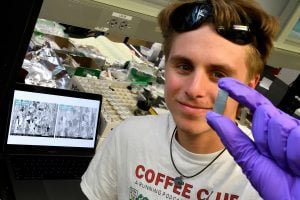
How do atoms interact when elements are combined into an alloy? It’s a longstanding question in materials science that Charlie Teeter is tackling. A senior materials science and engineering student, Teeter is building a model to figure out how atoms interact at the molecular level to improve alloy materials. He will present his findings at the Whiting School of Engineering’s Design Day on May 1.
“Researchers know which elements enhance material properties when they’re added to other elements, but not what occurs at the atomic level to trigger those improvements,” says Teeter. “My goal is to model how the atoms interact to improve those alloys.”
Inspired by his internship at ATI, an Oregon-based materials manufacturing company, Teeter is developing the model using aerospace materials like niobium alloys.
“Niobium is a great element to use in aerospace because it withstands high temperatures. It easily oxidizes, so it needs to be alloyed with other elements,” says Teeter. “I’m studying three alloys that are all 99% niobium and 1% titanium, hafnium, and zirconium—elements that are commonly used to improve niobium’s properties.”
Teeter is using recrystallization, a heating treatment to allow the growth of small new crystals to replace the initial crystal structure, to examine behavior changes when atoms from the three alloys merge.
“I’m looking at the distinctions of those 1% elements in the mechanisms of the recrystallization process – different furnace temperatures for various times. Then, I want to use a model to predict recrystallization behavior,” says Teeter.

To start, he prepared the niobium alloy samples for recrystallization, flattening them, and then using a glass-blowing technique to encapsulate them. The glass surrounding the samples protects them from oxidation, so they crystallize without turning to rust. Then, he places each sample into a furnace (hotter than 1000 degrees Celsius) for time frames between 1 minute and 2 hours, observing changes through a microscope. He then used the experiment results in an equation to build models of recrystallization prediction for the three alloys.
His results may have larger implications; by predicting outcomes of the 1% alloy, he hopes to someday anticipate how other atoms will react with niobium atoms.
“Over time, the goal is to expand this research to different atomic percentages and elements alloyed with niobium,” says Teeter. “Correctly predicting the exact moment of alloy crystallization can allow a new approach to answering the big questions in materials science.”
Teeter plans to continue his research at his position with ATI after graduation.